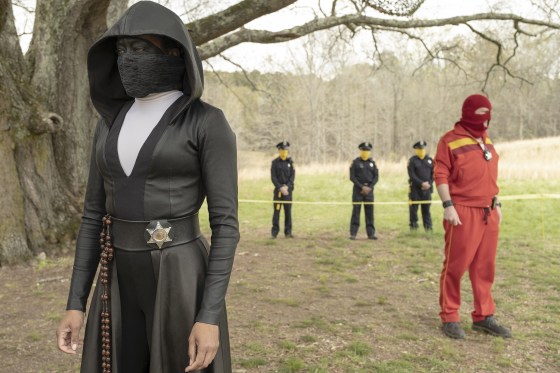HBO’s “Watchmen” is perhaps the most audacious comic book adaptation ever attempted. On the one hand, it fits HBO’s winning “Game of Thrones” formula to a tee. Take an established piece of fantasy, with a large cult following that is considered unadaptable, and turn it into Sunday night prestige television.
But “Watchmen” goes a step further. Instead of simply adapting the comic, showrunner Damon Lindelof (of “Lost” and “The Leftovers” fame) goes the revival route, imagining what the world of the comic would look like three decades later in the present day. Whether accidental or not, this strategy solves the problem of how to tailor the “unadaptable” “Watchmen” for the small screen. It turns out the trick to adapting “Watchmen” is, you don’t.
Instead of simply adapting the comic, showrunner David Lindelof goes the revival route, imagining what the world of the comic would look like three decades later in the present day.
When “Watchmen” the comic was released by Alan Moore and David Gibbons back in 1986, it was not just groundbreaking, it was transformative. The series threw out the traditional good vs. evil mythos that drove the genre for eons and instead asked how real masked vigilantes in 1930s New York City would have changed the historical arc of our world. What followed was less a superhero comic than a work of historical fiction. The rise of the superpowered Doctor Manhattan gave the U.S. a leg up and so we won in Vietnam, but it also helped President Richard Nixon repeal the 22nd Amendment and hide Watergate, allowing him to remain president well in the 1980s.
More importantly, the superheroes depicted were some seriously screwed up people. Great power didn’t cause anyone to step up and take great responsibility, most of the time. They were petty people with the same prejudices as everyone else. Those who did step up usually did so at the expense of those around them, following the adage that the needs of the many often outweigh the lives of the few.
And then there was the comic’s infamously bizarre conclusion: One day in 1985, a giant squid fell on Manhattan and the Cold War ended. The end.
HBO’s “Watchmen” picks up in 2019, 34 years after the squid incident (which people refer to as “the events of 11/2” in a clear 9/11 parallel.) The Cold War’s been over, and global peace has allowed America to worry about its domestic problems, specifically its history of slavery. President Robert Redford, a liberal balm after the Nixon years, has enacted a reparations program. In the absence of President Barack Obama, these “Redford-ations” are the tripwire that sets off the American divide between white supremacists and progressives.
This deeply American focus is the biggest break from the original “Watchmen” comic, and the smartest. Though the original “Watchmen” was set in New York, focused on Nixon and the U.S. side of the Cold War and followed the lives of mainly American born superheroes, the comic’s themes were actually very British. Intentional or not, Moore and Gibbons were writing a parable of Thatcherism in U.S. clothing.
Set in Tulsa, Oklahoma, Lindelof’s “Watchmen” is the story of America. And one still cannot tell the story of America without facing our racist past.
HBO’s “Watchmen” doesn’t do that. Set in Tulsa, Oklahoma, Lindelof’s “Watchmen” is the story of America. And one still cannot tell the story of America without facing our racist past.
The setting of Tulsa is not an accident. It gives Lindelof the chance to open with a real event somewhat lost to history: the destruction of Black Wall Street in 1921. The show’s cold open is dedicated to a very brutal recreation of the event, which turns out to have repercussions that are further reaching than anyone could have guessed. It also gives him a chance to play with the musical “Oklahoma!” The Rogers and Hammerstein musical is an extraordinary paean in this country; it’s so cloying, it almost plays like a parody in these cynical times. Lindelof also pays tribute to American television with a nearly perfect show within the show concept called “American Hero Story: Minutemen.”
Lindelof is helped along by an absolutely outstanding cast led by Regina King playing Angela Abar (who is also the masked vigilante superhero Sister Night.) Though other characters may grab the spotlight here and there, this is a King vehicle through and through, and she carries the mantle with aplomb. Other characters certainly get their due — Tim Blake Nelson, who plays her masked vigilante co-worker Looking Glass, for instance, has an episode dedicated to him that feels worthy of a supporting actor Emmy. Hong Chau is finally given a television role worthy of her talents as Lady Trieu. And then there’s Jeremy Irons and Jean Smart, who play now-aged versions of two major original characters from the “Watchman” comic. Both have a fine line to walk, as the bridge between the original material and the new and both pull it off astonishingly well.
That being said, the early episodes aren’t perfect. The premiere sets up a false dichotomy between white supremacists and cops, as if the two were somehow mutually exclusive. (Atatiana Jefferson and Botham Jean could testify otherwise.) Thankfully as the series goes on, this oddly nonsensical premise is dealt with. Also, there’s a lot of clever but obscure twists on the comic that aren’t well explained. (There will likely be a lot of googling of “why does it rain squids in Watchmen” after the first episode.)
But these quibbles aside, Lindelof has created something most would not have thought possible. He’s turned a serious “Watchmen” television adaption into one of the year’s most fascinating entertainment experiments. Even if it never gets a second season, it’s one worth watching.
CORRECTION (Oct. 21, 2019, 4 p.m.): An earlier version of this article misspelled the first name of the "Watchmen" showrunner. He is Damon Lindelof, not David.


